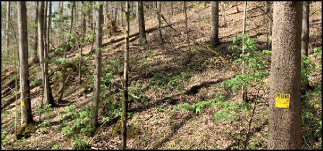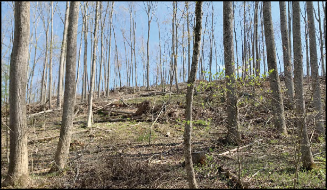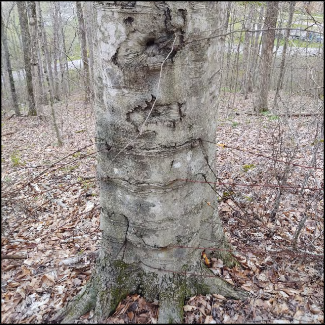Timber Theft in Virginia
ID
420-136 (CNRE-117NP)
Background
Woodlands provide recreational opportunities and ecosystem benefits such as wildlife habitat and clean water, and can also be an important source of income. Many landowners take careful steps to ensure that their property is managed to maximize these benefits. However, all of this work can be easily eradicated by one of Virginia’s most dreaded forest pests: timber thieves.
Timber theft is an attractive crime. It is not only highly profitable for thieves, but it is also difficult to catch and convict them. Because efforts to stop thieves have been so unsuccessful, the crime itself has generated very little publicity. As a result, many private landowners do not realize that timber theft is a problem that could affect their landholdings.
Timber theft usually falls into one of two categories. The first applies when the landowner has no relationship with the logger and trees are removed, either intentionally or unintentionally, without the landowner’s knowledge. Timber theft of this type is typically referred to as timber trespass. Certain properties are more at risk for this type of theft, including:
- Woodlands owned by absentee landowners who do not live on the property, especially those who do not live in the community. Approximately 22% percent of Virginia’s owners are absentee.
- Woodlands owned by folks who live locally, but for health or other reasons are unable to visit all of their property on a regular basis.
- Woodlands where there is an ongoing boundary dispute or deed overlap, or where there has been a historical difference of opinion on boundary lines.
- Woodlands adjacent to other properties with a current or proposed timber harvest.
- Woodlands that contain large, high-quality timber of valuable species.
The second category of timber theft applies when the landowner has an agreement with the logger, but the logger either fails to make payment or harvests more timber than what was agreed upon. This typically occurs when the timber has been sold as pay-as-cut or on shares (see Appendix 1 on timber sales methods). In Virginia, the landowner must be paid within the time period specified in the written timber sale contract or, if there is no contract, within 60 days from the date that the buyer removed the timber from the property. Failure to do so is a Class 1 misdemeanor.
Landowners can reduce the risk of timber theft on their land by taking a few steps.
Landowner Responsibilities
To reduce the risk of timber theft, all property boundaries should be properly marked and maintained. (See Appendix 2 on how to properly mark boundary lines.) Well-marked boundary lines protect the landowner, as well as owners of adjoining property. They also help timber buyers and loggers make accurate determinations of acreage and help prevent any accidental trespass (figure 1).

Additionally, landowners, or their designees, should walk the property regularly (at least once a year if possible) to maintain these boundary markers and check for signs of trespass. The sooner a timber trespass is identified, the easier it is to determine the value of the loss.

Landowners should also be aware of harvesting activities taking place on adjoining properties. During these times, boundary line monitoring should occur more frequently (figure 2).
The best way for landowners actively selling timber to protect themselves from timber theft is to have a well-written contract. At a minimum, the contract should spell out specifics such as:
- Type of work to be done.
- Consequences if the contract is not followed as agreed upon.
- Methods used to verify the type and amount of wood harvested.
- Documentation to be provided (such as load or scale tickets).
- How the process will be monitored.
- Consequences for not staying within the boundary lines.
- Length of contract.
- Payment terms.
- Types and amounts of insurance held by the contractor.
Having a written contract won’t guarantee that a buyer will pay in a timely manner, but it will give landowners a better legal standing if they go to court. Another option, which may or may not be appropriate, is for landowners to sell their timber as a lump sum sale and get paid in full before any trees are harvested.
Landowners may also want to monitor pay-as-cut or cut-on-share sales. This can be done by recording the number of loads that are removed from the property each day. Of course, this requires landowners or their designees to be present every day timber is being harvested. Another option to consider is installing a game camera near the entrance of the property. This could be used to remotely monitor the loads leaving the property.
Buyer/Contractor Responsibilities
Reputable buyers and harvesting contractors can also take steps to ensure timber theft doesn’t inadvertently happen.
Before any harvesting begins, they should make certain boundary lines are known and well-marked, and be sure the logging crew knows where they are. Once a harvest has begun, regular monitoring can help ensure the lines aren’t being crossed.
A buyer should also exercise due diligence when it comes to checking that the title to the land being harvested is free and clear and that all legal owners are aware of, and approve of, the sale. Filing a deed for the timber at the county courthouse will protect them from other claims on the timber for the length of the harvest contract.
In the case of pay-as-cut/cut-on-share sales, the buyer shall, at the request of the landowner, provide a true and accurate accounting of each load removed from the property. This accounting shall be provided within 30 days of the request or 30 days from the timber being removed from the property (whichever is later) and include:
- Load tickets or settlement statements from the facility receiving, weighing, scaling, or measuring trees, timber, or wood.
- Name of the receiving facility.
- Date the load was received by the facility.
- Name of the producer or logging company.
- Type of wood.
- Type of product(s).
- Weight or scale information, including total volume if the load is measured by scale (measuring the dimensions of saw logs) or the gross and tare or net weights if the load is measured by weight.
- Weight, scale, or amount of wood deducted for defects.
These reports are not required to include the price or market value information unless the timber sales agreement stipulated that the landowner is to be paid on shares. In that case, failure to provide this information or providing false information is a Class 3 misdemeanor.
Penalties
The penalty for theft that falls into the category of timber trespass (whether intentional or unintentional) requires several types of payment to the landowner:
- Three times the stumpage value of the timber (value of timber before it was cut).
- The cost of determining the value of the timber.
- Reforestation costs, not to exceed $450/acre.
- Any directly associated legal costs.
- Reasonable attorney fees incurred by the owner of the timber as a result of the trespass.
These remedies, particularly the triple stumpage value, are usually only available by court decree after a potentially lengthy legal battle. If the theft was clearly, or even likely, unintentional, it is often easier and less costly to reach a negotiated settlement with the harvester or adjoining landowner for the value of the timber and reforestation costs.
Restitution for the other category of timber theft, failure to fully pay a landowner in a timely manner, is payment of three times the value of the timber as established in the timber sale agreement, in addition to penalties imposed by the court.
What Landowners Can Do
The best course for landowners who believe they are a victim of timber theft may be to contact the trespasser or timber buyer to negotiate a settlement. This can be less time-consuming than pursuing legal action. If this strategy fails, landowners should call the local police department or county sheriff and their area Virginia Department of Forestry forester to report the theft. These reports need to be made within 90 days of discovery of the theft.
In the case of timber trespass, the landowner then hires an experienced forester who can determine the stumpage value (value of the trees when they were still standing) of the stolen trees. If the accused person does not deny the allegation within 30 days of receiving notification of the alleged trespass, he or she normally also hires an experienced forester to make a determination of the stumpage value. If the two foresters do not agree on an amount, a third experienced and disinterested person will be appointed to determine the value; that decision is final and conclusive, and not subject to appeal.
If the alleged trespasser fails to appoint an estimator within 30 days, or disputes the allegation, the forester appointed by the landowner may make the estimate, and any recovery will be based on that estimate.
In the case of failure to pay, landowners should submit, in writing, a demand for payment. Buyers then have 10 days to make the payment in full. If they fail to do so, they are subject to the failure to pay penalty.
Who Can Help Landowners?
The State Forester, employed by the Virginia Department of Forestry, has a duty to enforce all laws pertaining to forest and woodlands and prosecute any violation of such laws. Specifically, the Virginia Code states that the State Forester shall assist landowners and law enforcement agencies with regard to reported cases of timber theft. This responsibility is typically delegated to local or regional Department of Forestry personnel.
Records disclosed to the Virginia Department of Forestry that contain confidential commercial or financial information in the course of an investigation into timber theft are excluded from the mandatory disclosure provisions in the Virginia Freedom of Information Act.
Summary
Timber theft in Virginia falls in to two categories: timber trespass, when the landowner does not have a relationship with the logger, and failure to pay, when the landowner is actively doing business with the logger.
Certain types of properties and timber sales are more prone to timber theft. The best course of action is for landowners to take steps to reduce the risk of theft from occurring on their property. However, if timber theft does occur, landowners can take effective measures to get restitution.
This publication was based on the original publication 420-136 by Shawn Baker.
Appendix 1: Methods of Selling Timber*
In Virginia, timber is sold in three ways.
1. Lump sum
Landowners are paid in full for their timber, before any harvesting begins. The volume of timber is determined by a timber cruise. Interested buyers bid on the timber through a sealed bid process. The landowner or a consulting forester selects the winning bid. The winning bid is typically the highest, but in some circumstances, the landowner may go with a lower bid. Ideally, a written contract is signed.
Advantages: Landowners are paid up front and do not need to worry about getting paid. Once the landowners are paid, they are no longer responsible for the trees. The risk is passed on to the timber buyer (i.e., if anything happens to the trees before they are cut, the buyer loses out).
Disadvantages: If timber prices increase considerably during the contract period, landowners cannot demand more money. Contract length may be longer to allow adequate time for the buyer to harvest the timber purchased.
2. Pay-as-cut
Landowners do not receive an up-front lump-sum payment for their trees. Instead, the seller and buyer negotiate a price per unit ahead of the harvest and the buyer agrees to pay for the timber as it is cut. Landowners are paid only for the timber that is harvested. Payments are generally set up on a prearranged schedule (e.g., monthly, quarterly) and landowners are paid for what was cut during that period. The amount cut can be determined by weight, cord, or measured board feet. This type of sale is also called sale- by-unit.
Advantages: If the products are separated and merchandised correctly (e.g., saw logs are sold as saw logs, poles are sold as poles), landowners receive exactly what the timber is worth. There is no need for an intensive timber inventory to determine the exact volume on the tract. The exact volume will be determined as it is cut. Contract length may be shorter.
Disadvantages: Landowners retain ownership of the timber during the contract period and therefore assume all risk. If hurricane winds snap all the trees in half, the buyer is under no obligation to harvest them or pay the landowner. Landowners must work with a reputable buyer/contractor to ensure they are paid for all loads leaving their properties.
3. Cutting on shares
Landowners receive a percentage of the total value of each product. This type of timber sale is similar to pay-as-cut, but is based on percentages rather than a specific dollar amount for each unit of product cut. The percentage is negotiated prior to the harvest. The actual price per unit is dependent on the market and will fluctuate. A typical shares contract would involve a logger cutting the timber and selling the logs. The buyer of the logs would then write one check to the logger and another to the landowner. The proceeds from the sale are split between the landowner and the logger at an agreed- upon rate prior to the sale.
One key difference between pay-as-cut and cutting on shares is that the price the landowner is paid when cutting on shares will track the market. This can be beneficial when prices are up, but detrimental when prices are down.
*Timber sales in Virginia must observe the Silvicultural Water Quality Law to prevent nonpoint source pollution as a result of forest management activities. All timber sales in the commonwealth are inspected to ensure they are not violating this law. For details, search for “Monitoring Timber Harvesting BMP Implementation in Virginia” on the Virginia Department of Forestry page, http://www.dof.virginia.gov.
Appendix 2: A Widely Used Method for Marking Boundary Lines
If your boundary lines are known, you may permanently mark them by blazing trees, erecting piles of stones, or building a fence along the line. A common method of blazing trees involves marking healthy, vigorous trees that are at least 4 inches in diameter and not more than 100 feet apart. A drawknife or machete is used to scrape smooth 2-by-8-inch bands on the outer bark at roughly eye level (3 to 6 feet above the ground line) (figure 1). The blazes should face the boundary. See figure 2 for details on what types of blazes to use. Blazes should be painted using an exterior oil-based paint or a specialty boundary-line paint.
Boundary lines should be checked regularly and especially after a storm, nearby harvesting, fire, or insect and disease outbreaks. Remark the lines as necessary. Landowners who are not certain where their boundary lines are may need to hire a professional surveyor.


DISCLAIMER: It needs to be noted that many in the timber purchasing business and loggers are professionals and are honest. However, like all businesses, some are not. It is highly recommended that you get advice from trustworthy people such as a professional forester, the Virginia Department of Forestry, Virginia Cooperative Extension, the Virginia Loggers Association, the Virginia Forestry Association, or experienced family and friends before choosing someone to purchase standing timber.
Virginia Cooperative Extension materials are available for public use, reprint, or citation without further permission, provided the use includes credit to the author and to Virginia Cooperative Extension, Virginia Tech, and Virginia State University.
Virginia Cooperative Extension is a partnership of Virginia Tech, Virginia State University, the U.S. Department of Agriculture, and local governments. Its programs and employment are open to all, regardless of age, color, disability, sex (including pregnancy), gender, gender identity, gender expression, genetic information, ethnicity or national origin, political affiliation, race, religion, sexual orientation, or military status, or any other basis protected by law.
Publication Date
September 14, 2020



